Enacted by the state of South Carolina May 2,
2007: The twenty-seventh day of February
annually is designated
as 'General
Francis Marion Memorial Day'
in honor of this South Carolina Revolutionary
War hero."
Come and Celebrate
Rev. War Living History Encampment to
honor General Francis Marion.
Francis Marion Living
History Encampment at Camp Bob Cooper: Feb. 25-26, 2011 Best event ever.
Fun with history - Plan for Feb24-25, 2012
Visit the
Swamp Fox Murals
Trail. ©2002
Murals & Encampment:
Open to the Public for Free.
8th Francis
Marion/Swamp Fox Symposium:
October 15-16, 2010 Best One Yet
Plan now: Francis Marion Symposium
October 14-15, 2011.
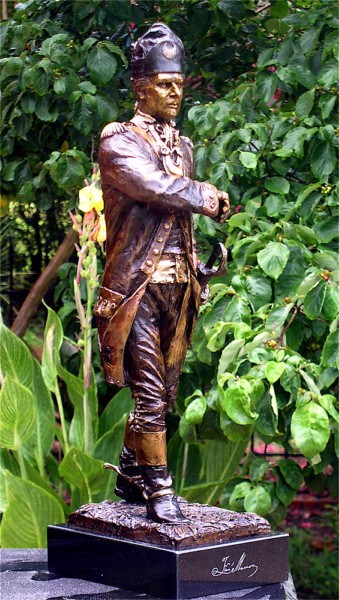
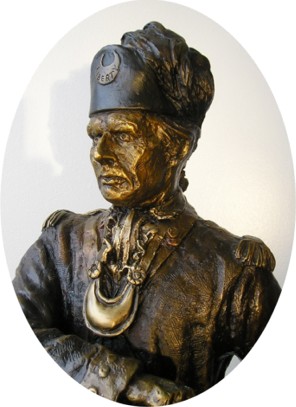
of his 2nd SC Regiment after he occupied Georgetown, June 6, 1781.
Marion Sculpture by Robert G. Barinowski ©2006 (http://baronsstudio.com ).
Marion is sponsored by the Swamp Fox Murals Trial Society.
Come to Manning to see Francis Marion at the corner of Mill and Boyce, opposite the clock on Courthouse Square.
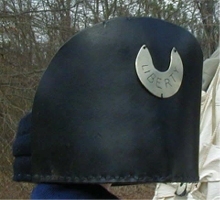 Directions: Southeast
of Summerton, I-95 Exit 102,
take Dingle Pond Road (SR 400)
east about 4.5 miles. Unmarked
site is on Santee Wildlife Refuge, Pine
Island Unit, and requires walking.
Directions: Southeast
of Summerton, I-95 Exit 102,
take Dingle Pond Road (SR 400)
east about 4.5 miles. Unmarked
site is on Santee Wildlife Refuge, Pine
Island Unit, and requires walking.
The stage for this battle was set when the British Lord Cornwallis defeated General Gates in a battle near Camden. De Kalb was killed and about 150 Marylanders were taken prisoner by the British. General Marion was ordered by Gates to roam the Santee burning boats so as to isolate Camden from Charleston. He was successfully engaged in this task when he learned of the defeat at Camden August 16, 1780. He withheld this information from his sixty troops and continued to burn boats. He learned from a deserter that a British Capt. Roberts with an escort of ninety troops was holding the 150 Maryland prisoners at General Sumter’s home, on the north savannah of the Santee River near Nelson’s Ferry. He attacked after dark and killed or captured twenty-three of the escorts and released all the prisoners, most of whom elected not to join Marion's Militia. This is thought to be the first time Cornwallis heard of General Marion.
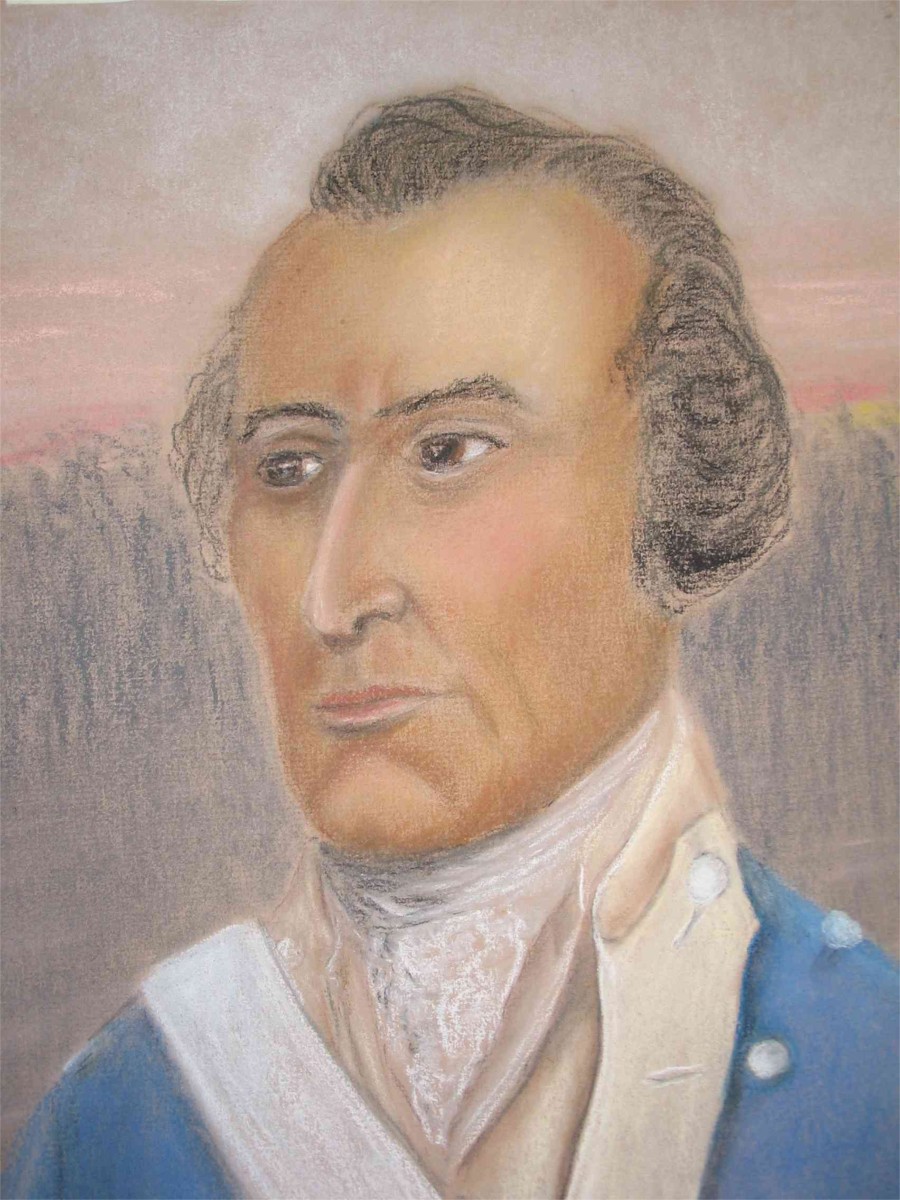
over 35 years of research on Marion, paints this depiction of Marion.
Reflections on General Francis Marion at General Francis Marion Memorial Day 2011 by Karen MacNutt.
General Thomas Sumter's vast land holdings and home were located on a bluff overlooking the Santee Basin about six miles from Nelson's Ferry. This was the 2nd location he lived in and the one used during the Revolution and it was burned by Tarleton. Sumter's first home was 1 mile NW of Eutaw Springs, SW of Nelson's Ferry, and his last holdings were at Stateburg.
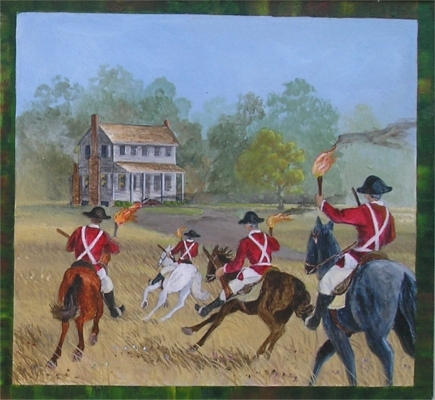 The Burning
of Mouzon's (August
7, 1780) Directions: I-95
Exit 132, Hwy 527, Black River Road, towards
Kingstree
The Burning
of Mouzon's (August
7, 1780) Directions: I-95
Exit 132, Hwy 527, Black River Road, towards
Kingstree Capt. William Henry Mouzon II was educated in France and spoke the language fluently. He became a surveyor and civil engineer. Henry Mouzon had known Banastre Tarleton from their boyhood days; yet so callous had Tarleton grown
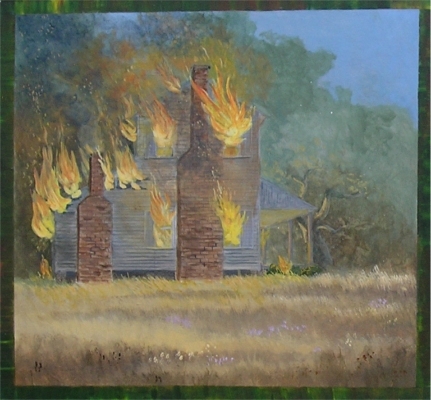 from
a sense of duty to his King that he burned
the Mouzon Plantation House, on August 7,
1780. His daughter
Ann recounted the day the British arrived.
She was eleven years old and was on top of
the smoke house at the time. Ann was the first to
see the British coming and sounded the alarm to
the rest of the family. The Mouzon home was at Mouzon's
Landing, located at Puddin' Swamp on the Black River
where Mouzon escaped into the swamp. His home was
on the edge of St Marks Parish, when Tarleton’s Green
Dragoons burned it.
Following this, British
Major James Wemyss burned out Patriots & Loyalists
alike in a swathe 15 miles wide of the 70 miles route
from Kingstree to Cheraw along the Black River in 1780.
from
a sense of duty to his King that he burned
the Mouzon Plantation House, on August 7,
1780. His daughter
Ann recounted the day the British arrived.
She was eleven years old and was on top of
the smoke house at the time. Ann was the first to
see the British coming and sounded the alarm to
the rest of the family. The Mouzon home was at Mouzon's
Landing, located at Puddin' Swamp on the Black River
where Mouzon escaped into the swamp. His home was
on the edge of St Marks Parish, when Tarleton’s Green
Dragoons burned it.
Following this, British
Major James Wemyss burned out Patriots & Loyalists
alike in a swathe 15 miles wide of the 70 miles route
from Kingstree to Cheraw along the Black River in 1780.Following Marion's victories at Nelson's Ferry and the Blue Savannah the British were angry. Cornwallis ordered available forces, over 1500 men,
 to go after Marion
and his 60 men. Marion, who
was guarding Port's Ferry on the Pee
Dee expected such a move and sent
Major James with a cavalry detachment
to snatch a British soldier so they could
question him. Thus, Marion learned he
was greatly out numbered so he broke
camp and moved to the Great White Marsh of North
Carolina. On his return he gathered
his followers and his first action resulted
in the victory over
Col. Ball at Black Mingo on September
28th. The Citizen Soldier mural
depicts Marion gathering
men as he returns from NC.
Citizen Soldier
Mural at SW corner of Sunset Dr. (US 301)
and Mill St. (SC 260), Manning, SC.
Mural ©2003
to go after Marion
and his 60 men. Marion, who
was guarding Port's Ferry on the Pee
Dee expected such a move and sent
Major James with a cavalry detachment
to snatch a British soldier so they could
question him. Thus, Marion learned he
was greatly out numbered so he broke
camp and moved to the Great White Marsh of North
Carolina. On his return he gathered
his followers and his first action resulted
in the victory over
Col. Ball at Black Mingo on September
28th. The Citizen Soldier mural
depicts Marion gathering
men as he returns from NC.
Citizen Soldier
Mural at SW corner of Sunset Dr. (US 301)
and Mill St. (SC 260), Manning, SC.
Mural ©2003Sept. 28-29, 1780 Marion, back in SC, attacked Col. Ball at Black Mingo, Mouzon was wounded.
While billeted near Waccamaw, General Marion learned Colonel Tynes with a party of over ninety Tories passed through Camden where they drew supplies and new muskets. They were now camped at the edge of Tearcoat Swamp, between the two forks of the Black River.

Marion called a muster and with 150 men moved to Kingstree. He then turned west and moved swiftly toward Tearcoat. After scouting the encampment Marion split his force into three companies and attacked at midnight. The attackers killed six, wounded fourteen and captured twenty-three men. They also captured the food, baggage, ammunition, over eighty new muskets and horses with saddles. However, Tynes escaped, but was captured a few days later in the High Hills (near Stateburg). Tearcoat Mural ©2002 Do a treasure hunt to find the historic marker: 33° 48' 51" N 80° 08' 33" W
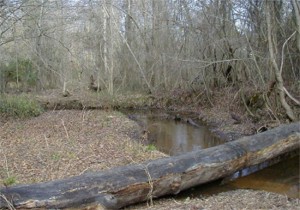 Confrontation at Richbourg's
Mill
(Tuesday, November 7, 1780)
*C-6
#8a
Map
Confrontation at Richbourg's
Mill
(Tuesday, November 7, 1780)
*C-6
#8a
MapColonel Banestre Tarleton with the Green Dragoons left Charleston to hunt down General Marion. Tarleton went to the late General Richardson’s home, bivouacked and lit several huge fires. General Marion, attracted by the light, began scouting the area. Mrs. Richardson sent he son Richard to warn Marion. When Marion learned of the ambush Tarleton had prepared he quickly withdrew to the east of Jack’s Creek, most likely to the area near Richbourg's mill and plantation.
Upon learning from a Tory spy that General Marion slipped back east of Jack’s Creek, Tarleton gave chase with his Green Dragoons. Marion, staying just ahead of the dragoons, and fighting a series of delaying tactics with his rear guard, rode to the head of Jack’s Creek, Sammy Swamp and then down the Pocotaligo and slipped away into Ox Swamp. Here Tarleton gave up the chase and said “as for the old fox, the devil himself could not catch him.” Thus, General Francis Marion became known as the “Swamp Fox”. Marion and his men continued east to Benbow's Ferry on the Black River where he had established the ambush for the British. Do a treasure hunt to find Ox Swamp: 33° 41' 32" N 80° 12' 03" W
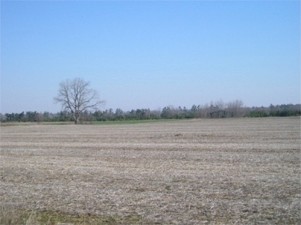 General Richardson Home
Site *C-2 #54 Map
General Richardson Home
Site *C-2 #54 Map
Directions: I-95 Exit 102, north on Historic US 301. At St. Paul turn left/west on Liberty Hill Road (SR 373), turn left on Old River Road (SR 76). Site is most likely on the right near the large tree, one-half mile west of St Phillips Church Road.
This is where Tarleton camped, started on the chase to Ox Swamp and returned to harass the Richardson family. He made Mrs. Dorothy Sinkler Richardson prepare dinner for him, then dug up Gen. Richard Richardson’s body, burnt the house and the barn with all the animals in it and finally flogged Mrs. Richardson in front of her children.
Benbow's Ferry Site Directions: East of Manning on SC 261. Left, north, onto S-55 at Martine Crossroads. The ferry was located just east of where the bridge crosses the Black River. Marion positioned his force in an ambush for Tarleton along the approach to the ferry.
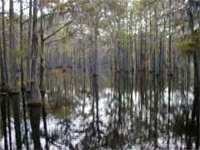 Directions: South
of Summerton, I-95
Exit 102 north on Historic US 301.
At St. Paul turn west on Liberty Hill
Road (SR 373), then left onto Old River
Road (SR 76). Site is on the left just
past Elliott’s Mill Pond and Spring Grove
Creek.
Directions: South
of Summerton, I-95
Exit 102 north on Historic US 301.
At St. Paul turn west on Liberty Hill
Road (SR 373), then left onto Old River
Road (SR 76). Site is on the left just
past Elliott’s Mill Pond and Spring Grove
Creek. Major McLeroth and his British Regular troops met at Nelson’s Ferry recruits for the Royal Fusiliers, who departed Charleston for Camden. McLeroth was to escort them to the High Hills. General Marion with 700 troops intercepted McLeroth’s group and began driving in the pickets. Under a flag of truce McLeroth complained and after they talked, it was decided each side would field twenty men to face off and fight. Major Vanderhorst and the picked twenty decided to wait until they were fifty yards away to fire their buckshot. As they closed to less than 100 yards, the Redcoats broke and ran. During the night the British stole away, leaving their equipment and supplies behind. Marion sent James and his cavalry after them. James fired on the British at Singleton’s Mill but quickly departed the mill area when he learned the Singletons had smallpox. Dec. 26, 1780, Lt. Col. John Watson Tadwell Watson and the British 64th Regiment of Foot troops started building Fort Watson on the Santee Indian Mound.
Do a treasure hunt to find the historic marker: 33° 39' 15" N 80° 29' 43" W
General Thomas Sumter had attacked Fort Watson atop the Indian Mound on February 28, 1781, attempting to take it from the British.
Directions: I-95 Exit 115. Take Historic US 301 north. Turn south (right) onto SC 260. Turn right on Patriot Road (SR 410). The site is at the end of the road.
Lt. Col. John Watson Tadwell Watson and Colonel Welbore Ellis Doyle were sent to encircle and crush General Marion. Early on March 5, Watson and his Buffs marched from Fort Watson down the Santee Path and bivouacked near Nelson’s Ferry. Marion heard their location from his spy, Capt. Zach Cantey.
His men knew they must fight to prevent the enemy from continuing to overrun their homes and farms. Marion ordered his troops to advance and set up an ambush, at Wyboo Swamp, a difficult pass on the Santee Road.
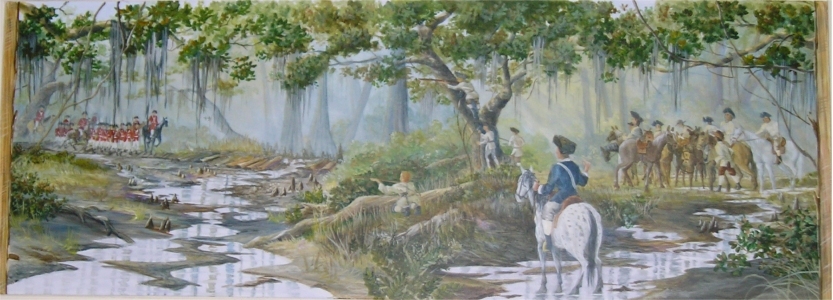 The British marched into
view and out rode Watson to
survey the scene. Out rode Marion
to face his opponent. The
quarter mile causeway spanned the muck and
morass of Wyboo swamp. Watson,
towering and majestically uniformed,
sitting a splendid charger and backed by
Britain's finest soldiers, opposite the small
Huguenot, sitting a sorrel gelding and backed
by farmers in homespun.
The British marched into
view and out rode Watson to
survey the scene. Out rode Marion
to face his opponent. The
quarter mile causeway spanned the muck and
morass of Wyboo swamp. Watson,
towering and majestically uniformed,
sitting a splendid charger and backed by
Britain's finest soldiers, opposite the small
Huguenot, sitting a sorrel gelding and backed
by farmers in homespun. Watson opened the battle. He sent Col. H Richborg and his Loyalist horsemen thundering over the causeway. Anticipating this, Marion sent Peter Horry and his horsemen to meet them. After a brief skirmish on the narrow roadway, both sides recoiled. Marion again ordered Horry to charge. Watson’s regulars held. A fusillade of grapeshot sent Horry’s cavalry reeling backward.
Do a treasure hunt to find the historic marker: 33° 32' 22" N 80° 13' 04" W
Directions: South of Manning, south on SC 260, left on Kenwood Road (S-323). Large brick and metal gate on the right, south side, of the road mark John Cantey’s Plantation.
Colonel Watson encamped at the Cantey Plantation on March 9th. He then attempted to join Doyle who was moving from Camden down the Pee Dee north of the Black River. At Mount Hope Swamp Watson met severe harassment from the Swamp Fox and his men. He again met stiff resistance at the Lower Bridge over the Black River and was unable to cross the river to reach Kingstree. He then camped at the Witherspoon and the Blakely plantations but was forced to head for Georgetown. He was ambushed and stopped at Ox Swamp and then made a dash for Georgetown via the Old River Road. When the British reached the Sampit River, General Marion ambushed them. Watson had suffered many casualties at every encounter and leaving his dead where they fell, he arrived at Georgetown with two wagons filled with wounded soldiers.
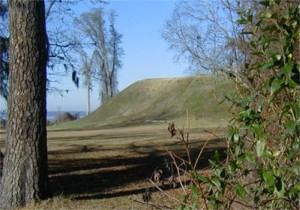 Siege
of Fort Watson
(Monday to Monday,
April 16-23, 1781)
*C-3 #37 Map
Siege
of Fort Watson
(Monday to Monday,
April 16-23, 1781)
*C-3 #37 MapDirections: I-95 Exit 102, South of Summerton. Historic US 301 north, turn west onto Fort Watson Road (S-803). Marker at the Visitors Center and the Indian Mound, site of Fort Watson, is at the end of the road.
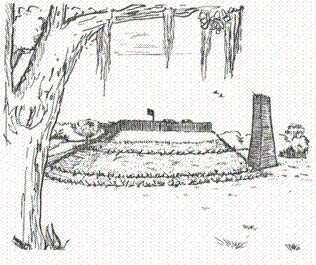 Colonel Harry Lee and Lee’s
Legion from Virginia had joined
General Marion and Marion’s Brigade
on the Black River on April 14, 1781.
Marion and Lee elected to capture
the British fort, built in December 1780,
Fort Watson on the Santee, to secure the area
and to get badly needed supplies. They
laid siege to the fort. While waiting
for a cannon to arrive, Major Maham suggested
building a tower and having sharpshooters pick
off the Redcoats inside the fort. The tower
was erected over night after collecting saplings
for several days. The use of the tower by the McCottry
riflemen at sunrise led to the quick surrender
of Fort Watson by Lt. James McKay on the morning
of April 23, 1781 and was the final Battle of
Fort Watson.
Colonel Harry Lee and Lee’s
Legion from Virginia had joined
General Marion and Marion’s Brigade
on the Black River on April 14, 1781.
Marion and Lee elected to capture
the British fort, built in December 1780,
Fort Watson on the Santee, to secure the area
and to get badly needed supplies. They
laid siege to the fort. While waiting
for a cannon to arrive, Major Maham suggested
building a tower and having sharpshooters pick
off the Redcoats inside the fort. The tower
was erected over night after collecting saplings
for several days. The use of the tower by the McCottry
riflemen at sunrise led to the quick surrender
of Fort Watson by Lt. James McKay on the morning
of April 23, 1781 and was the final Battle of
Fort Watson.
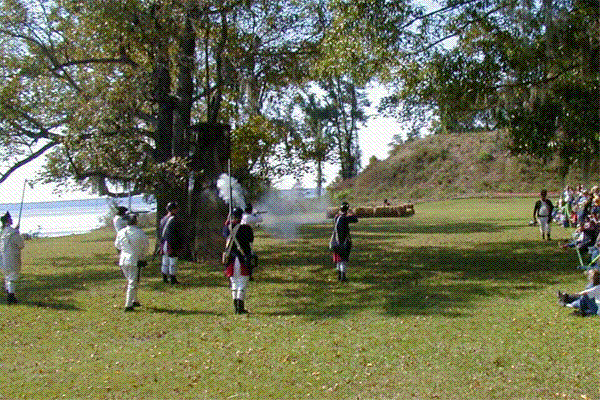
Re-enactment at Santee Indian Mound, Victory at Fort Watson Encampment October, 2003
 ©2002
©2002
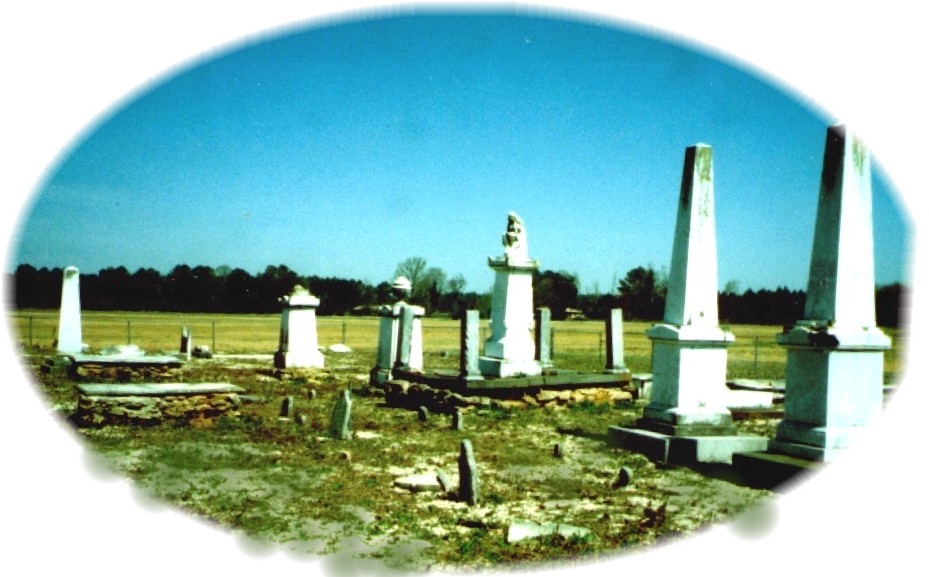 Richardson Cemetery
and St Mark's Parish Church *C-2 #54 Map
Richardson Cemetery
and St Mark's Parish Church *C-2 #54 Map
Directions: I-95 Exit 102 north on Historic US 301. At St. Paul turn west on SR 373, then left onto SR 76. Site is on the left just past Richardson Branch.
Likely on November 8, 1780, in an effort to teach the Richardsons and other Patriots a lesson for helping General Marion, Colonel Tarleton had his troops dig up General Richardson who was buried six weeks earlier and forced his family to view the body. Two SC governors and the founder of the Citadel are also buried here at this historic site. St. Mark’s Parish Church was located near here when the British burned it as they considered the church “a sedition shop”.
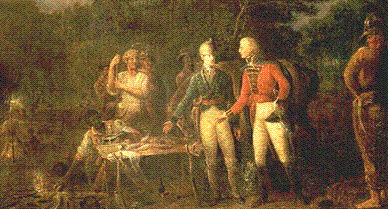 Francis Marion and the Sweet Potato Story
Francis Marion and the Sweet Potato Story
Francis Marion was in his camp near Snow Island on the Pee Dee River with his Militiamen. A British officer visited with Marion under a flag of truce to negotiate an exchange of prisoners. Marion offered him a meal consisting of sweet potatoes cooked in the ashes of the campfire and water to drink. The British officer returned to Charlestown and refused to fight against an enemy ( the Patriots) as dedicated as Francis Marion, "who ate roots cooked in a fire and drank nothing but water from the swamp."
There are about 12 different paintings that depict this event. All these paintings or etchings were done after General Marion died.
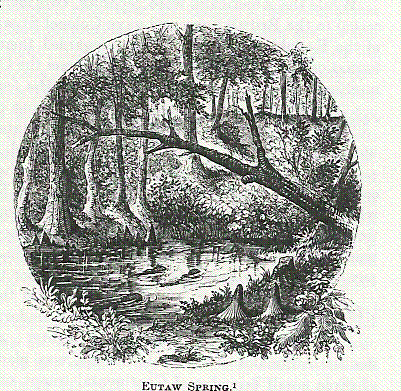 Eutaw Springs Battle
was Saturday, September
8, 1781. #44 Map
Eutaw Springs Battle
was Saturday, September
8, 1781. #44 Map
Directions: I-95 Exit 98 east on SC 6 to Eutaw Springs.
The Battle of Eutaw Springs was the last large battle fought in the campaign to end British occupation of the Carolinas and Georgia. On September 8, 1781, Major General Nathanael Greene's Continental Army accompanied by militia attacked the British Army under the command of Lt. Col. Alexander Stewart at Eutaw Springs. Over 4000 men fought for more than 4 hours in the stifling heat. It was the bloodiest battle of the Revolutionary War and soldiers reported wading through puddles of blood on the field and men were standing, dead, impaled on each other's bayonets. When the carnage was over, the British evacuated the area and moved to Chaleston Neck. Five weeks later, when the British surrendered at Yorktown, they had no claim to the Carolinas and Georgia. The Battle of Eutaw Springs had ended British control. (from Christine Swager: "The Valiant Died")
Do a treasure hunt to find the battlefield: 33° 24' 26" N 80° 17' 55" W
Francis Marion's Tomb is a SC State Site near Pineville: 33° 27' 14" N 80° 05' 14" W
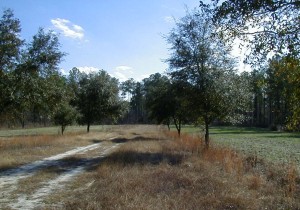
Directions: South of Manning, I-95 Exit 119 east on SC 261, south on SC 260, east on Kenwood Road (S-323). Large brick and metal gate on the right, south side, of the road mark Plantation.
John Cantey’s home was about halfway between Nelson’s Ferry and Murray’s Ferry. Gen. Marion was staying here when he learned that General Cornwallis surrendered at Yorktown on October 19, 1781. Joseph Cantey, John’s father, purchased the Mount Hope Plantation about 1739. It was located east of John’s near the present Cantey Cemetery.
Nov. 10, 1781, Saturday, Celebration party at John Cantey’s: “a fine party for the ladies of Santee”
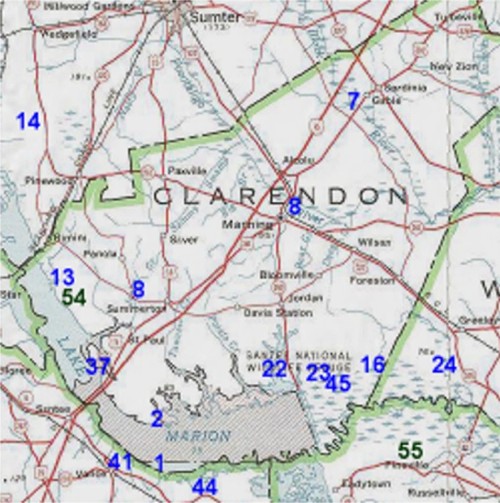 Swamp Fox Map
Swamp Fox Map| # On Clarendon Map
(above) |
Date |
Location |
| 1 |
1780-08-17 |
Nelson’s Ferry |
| 2 |
1780-08-25 |
Great Savannah |
| 7 |
1780-10-25 |
Tearcoat |
| 8a |
1780-11-08 |
Jack's Creek |
| 8b |
1780-11-08 |
Ox Swamp |
| 13 |
1780-12-12 |
Halfway Swamp |
| 14 |
1780-12-13 |
Singleton's Mill |
| 16 |
1780-12-17 |
Santee River Rd |
| 22 |
1781-03-06 |
Wiboo Swamp |
| 23 |
1781-03-06 |
Cantey Plantation |
| 24 |
1781-03-13 |
Mt. Hope Swamp |
| 37 |
1781-04-15 |
Fort Watson |
| 41 |
1781-08-16 |
Santee River |
| 44 |
1781-09-08 |
Eutaw Springs |
| 54 |
Richardson Cemetery |
|
| 55 |
1795-02-27 |
Marion's Tomb |
** Battles or skirmishes Marion engaged in **
Winter 1732 Marion was born in the Low Country of South Carolina, youngest of six.
1738 (c) Family moved to Winyah Bay close to Georgetown.
1747 (c) Francis went to sea. Disaster changed his mind about a career at sea.
1750 (c) Francis Marion's father died and Francis, unmarried, managed farm.
**1756 Francis and brother, Gabriel, enlisted to fight Indians. Indian fighter to 1761
1773 Francis purchased land on the Santee, 4 miles below Eutaw Springs.
April 19, 1775 Battles at Lexington and Concord, MA
May 1775 Marion learned of the struggle in New England and went to Charleston to Enlist, Commissioned as Captain on June 21, 1775, in SC Regiment.
June 18, 1776 South Carolina Regiments incorporated into Continental Army.
**June 28, 1776 British attack Sullivan's Island from the sea. Marion commanded the guns at the fort. (Now Fort Moultrie)
--- South Carolina troops serve in SC and GA. Most action is in New England
Summer 1779 Lord Cornwallis has orders from London for the Southern Campaign.
**October 9, 1779 Attempt to retake Savannah from British. Marion was involved
January 20, 1780 Marion, now a Lt. Col., commands the 2nd SC Regt.
March 19, 1780 Marion at a party at Tradd St. Jumped out window and broke leg or ankle. Evacuated from the besieged Charleston which fell May 12, 1780.
August 16, 1780 Camden fell, Cornwallis defeated Gates
**August 17, 1780 Marion (age 48) assumed command of the Williamsburg Militia; controlled Santee River traffic, boats destroyed
**August 24, 1780 Nelson's Ferry (Great Savannah), Santee River, Marion attacked British Soldiers conveying prisoners to Charleston.
**September 4, 1780 Blue Savannah, Marion ambushed Tories under Micah Ganey. Wemyss's Campaign of Terror. Marion at Great White Swamp (Waccamaw) in NC.
**Sept 7, 1780 Kingstree – Marion's Militia snatched Brit for interrogation
**Sept. 28-29, 1780 Marion, back in SC, attacked Col. Ball at Black Mingo, Mouzon wounded.
October 7, 1780 Battle at King's Mountain. (Marion not involved)
**October 25, 1780 Marion attacked Brits at Tearcoat Swamp, Black River, during the night.
**November 7, 1780 Confrontation at Richbourg’s Mill & Gen.Richardson’s Plantation/Big Home
**November 8, 1780 Jack’s Creek to Ox Swamp Chase, Marion became known as the “Swamp Fox”
**Nov. 15, 1780 Marion at White’s Plantation & Pen’s Plantation
Dec. 2, 1780 Greene took command from Gates
**Dec. 5, 1780 Tory Tavern
**Dec. 12, 13, 1780 Marion at Halfway Swamp near Santee River, and Singleton's Mill.
Dec. 16, 17, 1780 Reconnoitered Camden Outposts, Santee Road Recon/Interdiction
Dec. 28, 30, 1780 Camp near Georgetown, Chased Rangers from Williamsburg to Georgetown
January 14, 1781 Waccamaw
January 17, 1781 Battle of Cowpens, Morgan defeated Tarleton. (Marion not involved)
**January 25, 1781 Marion at Georgetown with Lee.
**January 29, 1781 Raided Moncks Corner & Congaree
**March 6-28, 1781 Marion at Wiboo Swamp, Mount Hope Swamp, Lower Bridge of the Black River at Kingstree and Sampit Bridge.
**April 15-23, 1781 Marion and Lee Siege of Fort Watson, Ft. fell with Maham Tower, Santee River
**May 6, 1781 Marion and Lee at Fort Motte
**May 28, 1781 Georgetown
**June 6, 1781 British evacuate Georgetown.
July 8, 1781 Moncks Corner & Orangeburg
**July 17, 1781 Marion and Lee at Quinby Bridge & Shubrick’s Plantation
August 4, 1781 Col. Isaac Hayne is hanged in Charleston.
**August 13, 1781 Marion ambushes Fraser and his Loyal SC Dragoons at Parker's Ferry Causeway
**Sept. 8, 1781 Battle of Eutaw Springs on Santee River
**Sept. 20, 1781 Port’s Ferry on Pee Dee River
October 19, 1781 Cornwallis surrendered at Yorktown
Nov. 9, 1781 Marion learns of Cornwallis surrendered
Nov. 10, 1781 Celebration party at John Cantey’s: “a fine party for the ladies of Santee”
**February 24, 1782 Two encounters with Loyalist cavalry. Tydiman Plantation Skirmish w/foragers
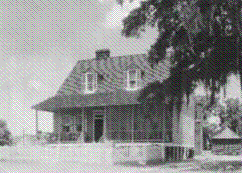
**August 29, 1782 Fair Lawn Skirmish, Marion encounters Fraser and is forced to retreat
December 14, 1782 British evacuated Charleston. Militia not allowed to participate and had been disbanded. Marion has returned to his home at Pond Bluff
April 20, 1786 Marion (age 53) married to Mary Esther Videau
Feb. 27, 1795 Marion died at his home at Pond Bluff, area presently under Lake Marion
Extensive research & the Paper: Francis Marion: Stranger Than
Fiction
Compiled
by Christine Swager & George
Summers
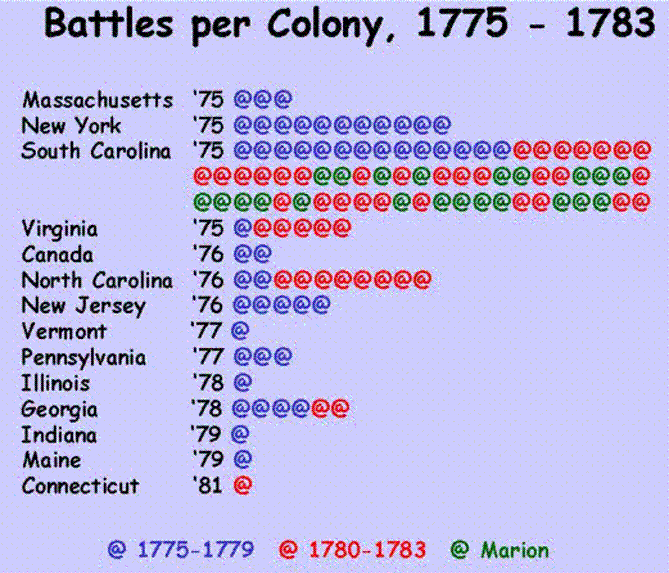
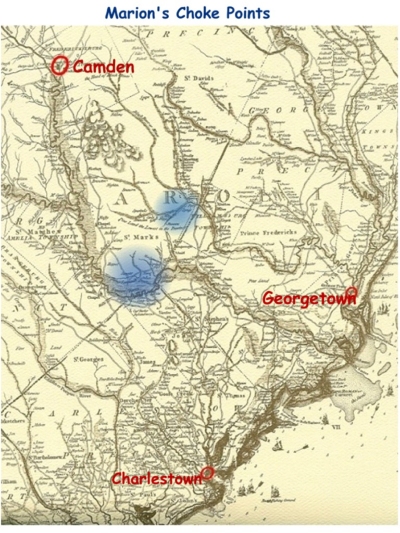
Choke points on the Santee River & Black River where Marion cut the British supply lines.
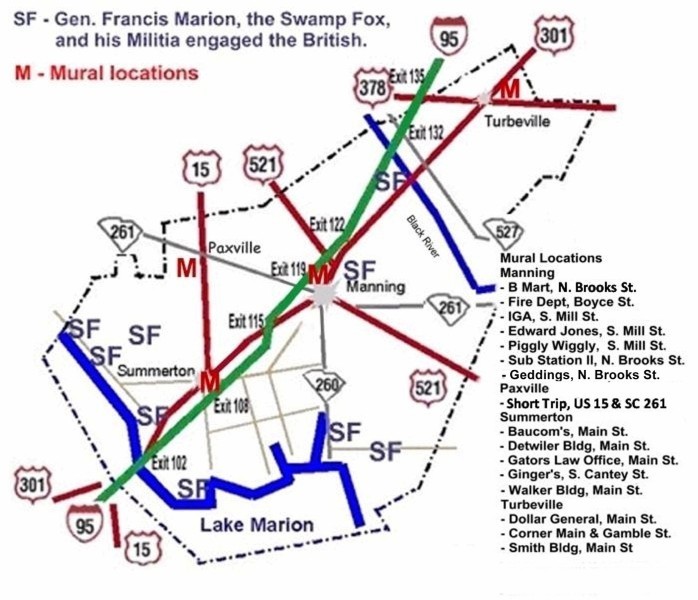
Battle of Nelson's Ferry or Battle of Great Savannah (August 20, 1780) *C-7 SF
Battle of Tearcoat (October 25, 1780) *C-27 SF
Confrontation at Richbourg's Mill (November 7, 1780) *C-6 SF
Chase to Ox Swamp (November 8, 1780) *C-25 SF
Battle of Half Way Swamp (December 17, 1780) *C-1 SF
Battle of Wyboo Swamp (March 6, 1781) *C-28 SF
Mount Hope Harassment (March 10-28, 1781) *C-29 SF
Siege of Fort Watson (April 16, 1781) *C-3 SF
Richardson Home Site & Cemetery (November 8, 1780) *C-2 SF
General Thomas Sumter's Plantation (November, 1780) *C-7 SF
John Cantey Plantation Site ( 1781) SF
(Maps available at Clarendon County Archives)
John R. Alden, A History of the American Revolution, 1969
David G. Anderson & Judith A. Carter, Archeological Survey…SNWR, 1979
Lawrence E. Babits, Southern Campaigns, 2002
D.W. Barefoot, Touring SC's Revolutionary War Sites, 1999
Robert D. Bass, Gamecock, 1961
Robert D. Bass, Swamp Fox, 1974
Mark M. Boatner III, Encyclopedia of the American Revolution, 1966
Douglas Bostick, Sunken Plantations, The Santee Cooper Project, 2008
Michael R. Bradley, It Happened In The Revolutionary War, 2003
Edward J. Cashin, William Bartram and the American Revolution on the Southern Frontier, 2000
William P. Cumming, North Carolina in Maps, 2001
Sidney W. Dean, Knight of the Revolution, 1941
John Drayton, Memoirs of the American Revolution , 1821
Robert M. Dunkerly, Redcoats on the River, 2008
Sir J. W. Fortescue, The War of Independence: The British Army in North America 1775-1783 , 1911
P. G. Gourdin, Life Along the Santee, 19??
Rod Gragg, Planters, Pirates and Patriots, 1985
William T. Graves, James Williams, An American Patriot, 2002
Francis Vinton Greene, General Greene, 1897
Cecil B. Hartley, Heroes and Patriots of the South, 1860. (Legacy Reprint)
Historical Documents, Revolutionary War Battlefield Map, 1962
Christopher Hibbert, Redcoats and Rebels, 1990
John Milton Hutchins, Bull’s Ferry Roundup, 2007
John Jakes, Kent Family Chronicles, Vol I, II, III
Gordon Bubber Jenkinson, Williamsburgh District, 2007
and a History of His Brigade, 1821
F. M. Kirk, Pond Bluff, 2000
Robert Lagemann and Albert C. Manuey, The Long Rifle, 1993
Robert Leckie, George Washington’s War, 1993
John J. Loeper, Going to School in 1776, 1973
Benson J. Lossing, Hours with the Living Men and Women, 1889, Scoggins, 2005
Silas E. Lucas, Jr., Mills' Atlas Of South Carolina, 1980 (1825)
Henry Lumpkin, From Savannah to Yorktown, 1981
Horatio Newton Moore, Francis Marion, 1845
Robert Morgan, Brave Enemies, 2003
of the American Revolution, 2004
Patrick O’Kelley, Nothing but Blood & Slaughter-Rev. War in the Carolinas, Vols. 3 & 4, 2005
James Otis, The Boy Spies With the Swamp Fox , 1899
James Otis, The Minute Boys of South Carolina, 1907
Howard H. Peckham, The War for Independence, 1958
Theda Perdue, The Cherokees, 2005
Jim Piecuch, The Battle of Camden, 2006
Jim Piecuch, Three Peoples, One King, Loyalists, Indians, & Slaves,2008
W. R. Pritchett, There is a Black River, 1930s?.
R. Randolph / James Otis, How We Boys Aided Marion the Swamp Fox, 1907
Hugh F. Rankin,
The North Carolina Continentals.
1971
Hugh F. Rankin,
North Carolina in the American
Revolution, 1959
Ray Raphael, A People's History of the American Revolution, 2001
Roe Richmond, Island Fortress, 1952
Parke Rouse, Jr., The Great Wagon Road, 1996
Leslie Sackrison, Awesome Women, 2007
Michael C. Scoggins, The Day It Rained Militia, 2005
W. Gilmore Simms, The Life of Francis Marion, 1844
Steven D. Smith, Obstinate and Strong, 2007
Steven D. Smith, The Search For Colonial Jacksonborough, 2008
Christine R. Swager, Heroes of Kettle Creek, 1779-1782 , 2008
Elswyth Thane, The Fighting Quaker: Nathanael Greene, 1972
Don Troiani, Soldiers in America, 1998
Daniel J. Tortora, A Faithful Ambassador, The SC Historical Magazine, 2006-7
John P. True, On Guard, 1927
Mao Tse-Tung, On Guerrilla Warfare, 1937 (2009)
Barbara W. Tuchman, The First Salute, 1988
George Washington, Rules of Civility & Decent Behaviour, Applewhite, 1988
Wylma A. Wates, A Flag Worthy of Your State and People, 1996
Russell F. Weigley, The American Way of War, 1973
Kenneth C. Weyand, Recipes & Stories of Early-Day Settlers, 1988
W. B. Wilcox, Clinton’s Narrative of The American Rebellion, 1954
Beryl Williams & Samual Epstein, Francis Marion, 1958
Scott Wimberley, Special Forces – Guerrilla Warfare Manual, 1997
Richard Yeadon, The Marion Family, Southern & Western Magazine & Review, 1845
A-1
Marion request letter, Sullivan’s Island, 26 July 1778
Marion appointment to Lieutenant Colonel, 16 September 1776 (dated 12 April 1782)
Marion Letter, Salem Black, 6 Feb 1781
Marion reciept, Camp Peedee River, 19 Feb 1781
Marion Congressional Citation, 12 April 1782
Marion Letters, City of Charleston Yearbook, 1895
Marion Article, Sanders R. Guignard family, Dec. 26, 2002
Marion Presentation, The Man and The Myth, Lauren Pougue, April, 2003
Marion Presentation, Christine Swager, Francis Marion, Stranger then Fiction, April, 2003
Marion-Gadsden Correspondence, SC Historical Madazine
Francis Marion’s Hunting Lodge, Nettie Smith Owings, Huguenot Society of SC, 1975
Pond Bluff, F. M. Kirk, Geocities, 4/6/99
The Swamp Fox, Hugh M. McLaurin, III, Nov. 16, 1988
Marion Letters, City of Charleston Yearbook
Francis Marion, Frankie Anderson, 1994
Francis Marion Statement, re. plundering, 29 April 1790
News Article, Pennsylvania Packet, 10-09-1781
News Article, Pennsylvania Evening Post, August 14, 1781
Letter, Lt. Col Balfour to Lord George Germain, May 1, 1781
Letter, Gen Green, McCord’s Ferry, May 14, 1781
Marion Letter, re. Fort Watson, 23 April, 1781
A-2
Marion request letter, April 21, 1781
News Article, Richmond, April 6, 1782
News Article, New Jersey Gazette, April 1, 1781
Marion Letter to Gen Greene, Pennsylvania Packet, March 6, 1781
Marion Letter to Gen Greene, Pennsylvania Packet, January 31, 1781
News Article, Pennsylvania Packet, January 9, 1781
News Article, NY Royal Gazette, Sep 20, 1780 (About Nelson’s Ferry and 150 Marylanders)
News Article, Marion Letter, NE Chronicle, Jan 18, 1781
News Article, Royal SC Gazette, Nov 16, 1780
Francis Marion Orderly Book Presentation, John Frierson, April, 2003
Trail of The Swamp Fox, Douglas H. Bennett, Jul-Aug 2000, SC Wildlife
Francis Marion as an Intelligence Officer, George W. Kyte, SC Historical Magazine
Francis Marion, Carologue, Spring 2004, Intelligence
The Life of Francis Marion, D. W. Stokes, est. 1926, reprinted 1974
The Order Books of Francis Marion, Discipline by the Lash, John L. Friarson, Carologue, Winter 1999
General Marion’s Sweet Potatoe Dinner, unknown, facts/myths wrong
New Facts about an Old Story, Nell Weaver Davies, Carologue, Winter 1999
Who Was the Swamp Fox, Interview with Leslie Nielson, Paul F. Anderson
Francis Marion, Benson J. Lossing, Harper’s New Monthly Magazine, July, 1858.
Haunts of “The Swamp Fox”, P. D. Hay, Harper’s New Monthly Magazine
Simm’s Life of Marion, review, Jan 1845
Charles Baxley, Daniel Bell, Scott Bell, Dr. Anthony Beninati, Jeannette Beranger,
Fin Coffey, Mike Coker, Windy Corbett, Janson Cox, Doug Crutchfield, Dan Culpepper,
Dr. Marion Davis, Dr. Walter Edgar, Dr. Elizabeth Fenn, Dr. George Fields,
John Frierson, Harold Furse, Christopher George, David Grant, Val Green, Doyle Harper,
Justin Liles, Dr. Karen MacNutt, Norman McFadden, Dr. Warner Montgomery, Joe Moore,
Erick Nason, Patrick O’Kelley, Lauren Pogue, Dr. Tom Powers, Herb Puckett, John Robertson,
Dr. David Ruwer,Nicki Sackrison, Ross St. George, Steve Smith, Dwight Stewart, Frank Stovall,
Dr. Joe T. Stukes, Dr. Bob Swager, Dr. Christine Swager, Dr. Dan Tortora, Dr. Wright Turbeville,
Luther Wannamaker, Richard Watkins, Athena Westeren, Scott Withrow
 Ox Swamp
Mural
©2001
General
Marion enticing British
Col. Tarleton into Ox Swamp
Ox Swamp
Mural
©2001
General
Marion enticing British
Col. Tarleton into Ox Swamp 